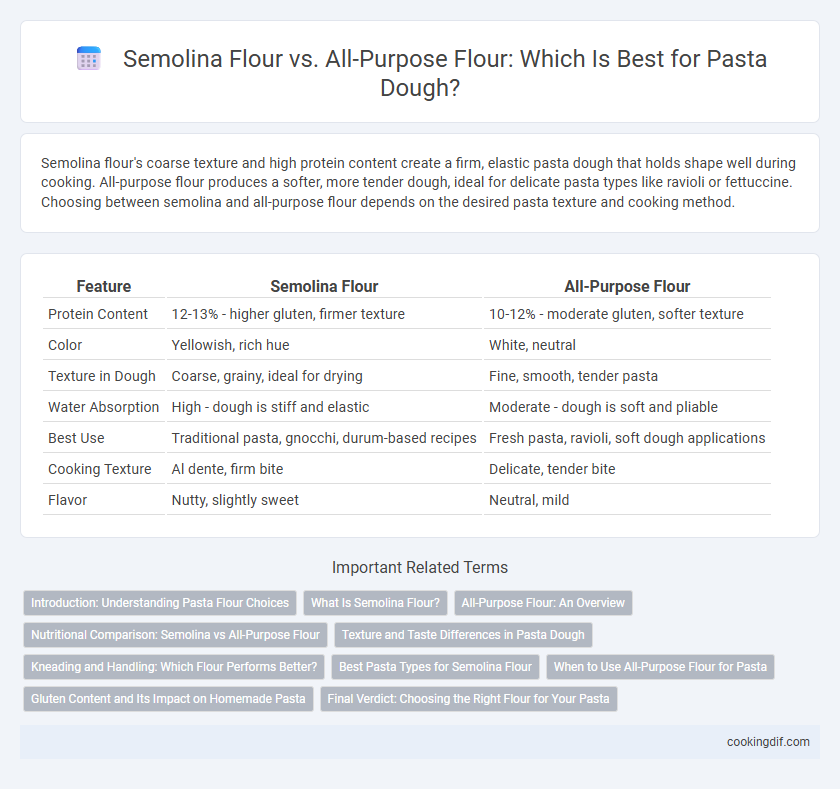Semolina flour's coarse texture and high protein content create a firm, elastic pasta dough that holds shape well during cooking. All-purpose flour produces a softer, more tender dough, ideal for delicate pasta types like ravioli or fettuccine. Choosing between semolina and all-purpose flour depends on the desired pasta texture and cooking method.
Table of Comparison
| Feature | Semolina Flour | All-Purpose Flour |
|---|---|---|
| Protein Content | 12-13% - higher gluten, firmer texture | 10-12% - moderate gluten, softer texture |
| Color | Yellowish, rich hue | White, neutral |
| Texture in Dough | Coarse, grainy, ideal for drying | Fine, smooth, tender pasta |
| Water Absorption | High - dough is stiff and elastic | Moderate - dough is soft and pliable |
| Best Use | Traditional pasta, gnocchi, durum-based recipes | Fresh pasta, ravioli, soft dough applications |
| Cooking Texture | Al dente, firm bite | Delicate, tender bite |
| Flavor | Nutty, slightly sweet | Neutral, mild |
Introduction: Understanding Pasta Flour Choices
Semolina flour, made from durum wheat, provides a coarse texture and high protein content that enhances pasta's firmness and bite, ideal for traditional Italian pasta. All-purpose flour, with a finer grind and moderate protein level, creates a softer and more tender dough, suitable for delicate pasta varieties. Choosing between semolina and all-purpose flour significantly impacts pasta dough's elasticity, cooking performance, and final texture.
What Is Semolina Flour?
Semolina flour is a coarse, high-protein flour made from durum wheat, known for its gritty texture and pale yellow color, which gives pasta a firm structure and slightly nutty flavor. It absorbs water better than all-purpose flour, resulting in dough that is easier to handle and less sticky, ideal for traditional Italian pasta like gnocchi or spaghetti. Semolina's high gluten content enhances elasticity and chewiness, distinguishing it from the softer, more versatile all-purpose flour commonly used in general baking.
All-Purpose Flour: An Overview
All-purpose flour is a versatile, moderately protein-rich flour commonly used in pasta dough for its ability to produce a tender, pliable texture. It contains about 10-12% protein, which helps develop gluten, providing elasticity and structure while maintaining softness in the final pasta. All-purpose flour's balanced starch content allows it to absorb water evenly, making it suitable for a variety of pasta shapes and cooking methods.
Nutritional Comparison: Semolina vs All-Purpose Flour
Semolina flour contains higher protein content, typically around 12-13%, compared to all-purpose flour's 8-11%, which contributes to a firmer and more elastic pasta dough. Semolina is richer in gluten, essential for pasta structure, and provides more dietary fiber, iron, and B vitamins, supporting digestion and energy metabolism. All-purpose flour has a finer texture and slightly lower nutritional value, making semolina a healthier choice for traditional pasta recipes with enhanced texture and nutritional benefits.
Texture and Taste Differences in Pasta Dough
Semolina flour produces pasta dough with a coarser texture and a slightly nutty flavor, creating a firm bite perfect for traditional Italian pasta shapes. All-purpose flour yields a smoother, more elastic dough that results in softer pasta with a mild taste, making it versatile for various recipes. The higher protein content in semolina enhances the dough's structure and chewiness, while all-purpose flour's balanced gluten content offers ease of handling and a delicate mouthfeel.
Kneading and Handling: Which Flour Performs Better?
Semolina flour creates a firmer, more elastic pasta dough due to its higher protein and gluten content, making kneading and handling easier with less stickiness. All-purpose flour results in a softer dough that can be more challenging to work with, often requiring additional flour to prevent sticking during rolling. For pasta dough requiring resilience and smooth handling, semolina flour consistently outperforms all-purpose flour.
Best Pasta Types for Semolina Flour
Semolina flour, made from durum wheat, provides a gritty texture and high protein content ideal for extruded pasta shapes like penne, rigatoni, and fusilli, which hold sauce well due to their sturdy structure. Unlike all-purpose flour, semolina's coarse grind enhances pasta's bite and firmness, making it the preferred choice for traditional Italian pasta such as orecchiette and cavatelli. While all-purpose flour produces smoother, more delicate dough suited for ravioli and fettuccine, semolina excels in crafting robust pasta that maintains texture during boiling and sauce application.
When to Use All-Purpose Flour for Pasta
All-purpose flour is ideal for fresh pasta dough when a softer texture is desired, such as for filled pastas like ravioli or tortellini. Its moderate protein content provides enough gluten development for elasticity without making the dough too firm. Using all-purpose flour results in tender pasta that holds fillings well and cooks quickly.
Gluten Content and Its Impact on Homemade Pasta
Semolina flour, made from durum wheat, contains higher gluten levels than all-purpose flour, providing a firm texture and excellent elasticity essential for pasta dough. The increased gluten content results in a sturdier, chewier pasta that holds shape well during cooking, ideal for traditional Italian pasta varieties like spaghetti and penne. In contrast, all-purpose flour yields softer, less elastic dough, which can be easier to work with but may produce pasta that is less resilient and more prone to breaking.
Final Verdict: Choosing the Right Flour for Your Pasta
Semolina flour, made from durum wheat, provides a coarse texture and high gluten content, resulting in a firm, chewy pasta ideal for traditional shapes like penne and rigatoni. All-purpose flour, with its moderate protein level, creates a softer, more pliable dough suitable for delicate pastas such as fettuccine or ravioli. Selecting semolina flour offers superior structure and bite for robust pasta, while all-purpose flour provides versatility and ease for tender, smooth noodles.
Semolina flour vs all-purpose flour for pasta dough Infographic

 cookingdif.com
cookingdif.com